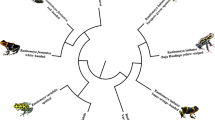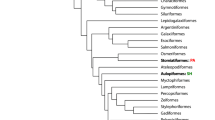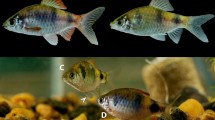Abstract
Vertebrate pigmentation is emerging as a powerful system for studying the evolution of adaptive traits and the maintenance of genetic and phenotypic variation in natural populations. Though melanism has been linked to physiological and behavioral traits in a variety of taxa, the generality of these associations for many taxa such as fishes remains unclear. Here I tested whether variation in melanism in a livebearing fish was correlated with a variety of traits often tested in other taxa: locomotor stress coping style during confinement, boldness in a novel environment, and metabolic rate. There were significant negative associations between an individual’s amount of melanistic pigmentation and both activity in confinement and boldness in a novel environment. In contrast with evidence from many prior studies, there was no relationship between melanism and metabolic rate. Overall, the data provide some support for documented relationships between melanism and behavioral traits, but did not support the generally reported relationship between melanism and metabolic rate. Links between melanism and behavioral coping strategies related to environmental stressors may have important implications for the evolution and maintenance of behavioral and morphological variation in natural populations. Nonetheless, these results also suggest variation among taxa in the extent to which pleiotropy has evolved between melanism and diverse organismal traits.


Similar content being viewed by others
References
Allen BJ, Levinton JS (2007) Costs of bearing a sexually selected ornamental weapon in a fiddler crab. Funct Ecol 21:154–161
Basolo AL, Alcaraz G (2003) The turn of the sword: length increases male swimming costs in swordtails. Proc R Soc Lond B Biol Sci 270:1631–1636
Bürger R, Gimelfarb A (2002) Fluctuating environments and the role of mutation in maintaining quantitative genetic variation. Genet Res 80:31–46
Culumber ZW (2014) Pigmentation in Xiphophorus: an emerging system in ecological and evolutionary genetics. Zebrafish 11:57–70
Culumber ZW, Monks S (2014) Does fin coloration signal social status in a dominance hierarchy of the livebearing fish Xiphophorus variatus? Behav Process 107:158–162
Culumber ZW, Rosenthal GG (2013) Mating preferences do not maintain the tailspot polymorphism in the platyfish, Xiphophorus variatus. Behav Ecol 24:1286–1291
Culumber ZW, Tobler M (accepted) Spatiotemporal environmental heterogeneity and the maintenance of the tailspot polymorphism in the variable platyfish (Xiphophorus variatus) Evolution
Culumber ZW, Bautista-Hernández CE, Monks S (2014) Physiological stress and the maintenance of adaptive genetic variation in a livebearing fish. Evol Ecol 28:117–129
Culumber ZW, Schumer M, Monks S, Tobler M (2015) Environmental heterogeneity generates opposite gene-by-environment interactions for two fitness-related traits within a population. Evolution 69:541–550
Ducrest A-L, Keller L, Roulin A (2008) Pleiotropy in the melanocortin system, coloration and behavioural syndromes. Trends Ecol Evol 23:502–510
Fargallo JA, Velando A, López-Rull I, Gañán N, Lifshitz N, Wakamatsu K, Torres R (2014) Sex-specific phenotypic integration: endocrine profiles, coloration, and behavior in fledgling boobies. Behav Ecol 25:76–87
Fry FEJ (1957) The aquatic respiration of fish. In: Brown ME (ed) The physiology of fishes. Academic Press, New York, pp 1–63
Gillespie JH, Turelli M (1989) Genotype–environment interactions and the maintenance of polygenic variation. Genetics 121:129–138
Haney DC, Nordlie FG (1997) Influence of environmental salinity on routine metabolic rate and critical oxygen tension of Cyprinodon variegatus. Physiol Zool 70:511–518
Hoback WW, Wagner WE (1997) The energetic cost of calling in the variable field cricket, Gryllus lineaticeps. Physiol Entomol 22:286–290
Hoekstra HE (2006) Genetics, development and evolution of adaptive pigmentation in vertebrates. Heredity 97:222–234
Hubbard JK, Uy JAC, Hauber ME, Hoekstra HE, Safran RJ (2010) Vertebrate pigmentation: from underlying genes to adaptive function. Trends Genet 26:231–239
Johnson JB, Culumber ZW, Easterling R, Rosenthal GG (2015) Boldness and predator evasion in naturally hybridizing swordtails (Teleostei: Xiphophorus). Curr Zool 61:596–603
Kittilsen S, Schjolden J, Beitnes-Johansen I, Shaw JC, Pottinger TG, Sørensen C, Braastad BO, Bakken M, Øverli Ø (2009) Melanin-based skin spots reflect stress responsiveness in salmonid fish. Horm Behav 56:292–298
Krause J, Loader SP, McDermott J, Ruxton GD (1998) Refuge use by fish as a function of body length-related metabolic expenditure and predation risks. Proc R Soc Lond B Biol Sci 265:2373–2379
Kronforst MR, Barsh GS, Kopp A, Mallet J, An Monteiro, Mullen SP, Protas M, Rosenblum EB, Schneider CJ, Hoekstra HE (2012) Unraveling the thread of nature’s tapestry: the genetics of diversity and convergence in animal pigmentation. Pigment Cell Melanoma Res 25:411–433
Mafli A, Wakamatsu K, Roulin A (2011) Melanin-based coloration predicts aggressiveness and boldness in captive eastern Hermann’s tortoises. Anim Behav 81:859–863
Nachman MW, Hoekstra HE, D’Agostino SL (2003) The genetic basis of adaptive melanism in pocket mice. Proc Natl Acad Sci 100:5268–5273
Norin T, Malte H (2011) Repeatability of standard metabolic rate, active metabolic rate, and aerobic scope in young brown trout during a period of moderate food availability. J Exp Biol 214:1668–1675
Øverli Ø, Sorensen C, Pulman KGT, Pottinger TG, Korzan W, Summers CH, Nilsson GE (2007) Evolutionary background for stress-coping styles: relationships between physiological, behavioral, and cognitive traits in non-mammalian vertebrates. Neurosci Biobehav Rev 31:396–412
Passow CN, Greenway R, Arias-Rodriguez L, Jeyasingh PD, Tobler M (2015) Reduction of energetic demands through modification of body size and routine metabolic rates in extremophile fish. Physiol Biochem Zool 88:371–383
Pirozzi I, Booth MA (2009) The routine metabolic rate of mulloway (Argurosomus japonicus: Sciaenidae) and yellowtail kingfish (Seriola lalandi: Carangidae) acclimated to six different temperatures. Comp Biochem Physiol A 152:586–592
Pottinger TG, Carrick TR (2001) Stress responsiveness affects dominant-subordinate relationships in rainbow trout. Horm Behav 40:419–427
Réale D, Garant D, Humphries MM, Bergeron P, Careau V, Montiglio P-O (2010) Personality and the emergence of the pace-of-life syndrome concept at the population level. Philos Trans R Soc B Biol Sci 365:4051–4063
Rosenblum EB, Hoekstra HE, Nachman MW (2004) Adaptive reptile color variation and the evolution of the MCIR gene. Evolution 58:1794–1808
Roulin A, Ducrest A-L (2011) Association between melanism, physiology and behaviour: a role for the melanocortin system. Eur J Pharmacol 660:226–233
Schartl M, Walter RB, Shen Y, Garcia T, Catchen J, Amores A, Braasch I, Chalopin D, Volff J-N, Lesch K-P (2013) The genome of the platyfish, Xiphophorus maculatus, provides insights into evolutionary adaptation and several complex traits. Nat Genet 45:467–472
Schjolden J, Backström T, Pulman KG, Pottinger TG, Winberg S (2005) Divergence in behavioural responses to stress in two strains of rainbow trout (Oncorhynchus mykiss) with contrasting stress responsiveness. Horm Behav 48:537–544
Seibel BA, Drazen JC (2007) The rate of metabolism in marine animals: environmental constraints, ecological demands and energetic opportunities. Philos Trans R Soc B Biol Sci 362:2061–2078
Sih A, Bell A, Johnson JC (2004) Behavioral syndromes: an ecological and evolutionary overview. Trends Ecol Evol 19:372–378
Spichtig M, Kawecki TJ (2004) The maintenance (or not) of polygenic variation by soft selection in heterogeneous environments. Am Nat 164:70–84
Steffensen JF (1989) Some errors in respirometry of aquatic breathers: how to avoid and correct for them. Fish Physiol Biochem 6:49–59
Timmerman CM, Chapman LJ (2003) The effect of gestational state on oxygen consumption and response to hypoxia in the sailfin molly, Poecilia latipinna. Environ Biol Fishes 68:293–299
Timmerman CM, Chapman LJ (2004a) Behavioral and physiological compensation for chronic hypoxia in the sailfin molly (Poecilia latipinna). Physiol Biochem Zool 77:601–610
Timmerman CM, Chapman LJ (2004b) Hypoxia and interdemic variation in Poecilia latipinna. J Fish Biol 65:635–650
Turelli M, Barton NH (2004) Polygenic variation maintained by balancing selection: pleiotropy, sex-dependent allelic effects and G × E interactions. Genetics 166:1053–1079
Ultsch GR, Boschung H, Ross MJ (1978) Metabolism, critical oxygen tension and habitat selection in darters (Etheostoma). Ecology 59:99–107
van den Brink V, Henry I, Wakamatsu K, Roulin A (2012) Melanin-ased coloration in juvenile kestrels (Falco tinnunculus) covaries with anti-predatory personality traits. Ethology 118:673–682
Via S, Lande R (1987) Evolution of genetic variability in a spatially heterogeneous environment: effects of genotype–environment interaction. Genet Res 49:147–156
Wolf M, Van Doorn GS, Leimar O, Weissing FJ (2007) Life-history trade-offs favour the evolution of animal personalities. Nature 447:581–584
Zhang X-S, Hill WG (2005) Evolution of the environmental component of the phenotypic variance: stabilizing selection in changing environments and the cost of homogeneity. Evolution 59:1237–1244
Acknowledgments
I would like to thank the federal government of Mexico for permission to collect fish. Z.W.C. was supported as a postdoctoral scholar by Consejo Nacional de Ciencia y Tecnología (CONACyT) Mexico—Clave 0127310 grant in basic science to William Scott Monks.
Author information
Authors and Affiliations
Corresponding author
Electronic supplementary material
Below is the link to the electronic supplementary material.
Supplementary Fig. 1.
Pigmentation traits are easily identified and distinguished in life and photographed specimens of X. variatus. In the upper photograph numbers indicate pigmentation patterns not quantified as melanistic spotting for the present study: (1) tailspot pattern, (2) false brood spot, and (3) vertical bars. The lower photograph illustrates a fish with a crescent tailspot (4) and melanistic spotting is easily observable. (PDF 231 kb)
Supplementary Fig. 2.
There was no relationship between melanism and routine metabolic rate in adult X. variatus (N = 56; 19 females, 37 males; β = -0.069, t = -0.582, P = 0.583). (PDF 90 kb)
Rights and permissions
About this article
Cite this article
Culumber, Z.W. Variation in the evolutionary integration of melanism with behavioral and physiological traits in Xiphophorus variatus . Evol Ecol 30, 9–20 (2016). https://doi.org/10.1007/s10682-015-9807-2
Received:
Accepted:
Published:
Issue Date:
DOI: https://doi.org/10.1007/s10682-015-9807-2




